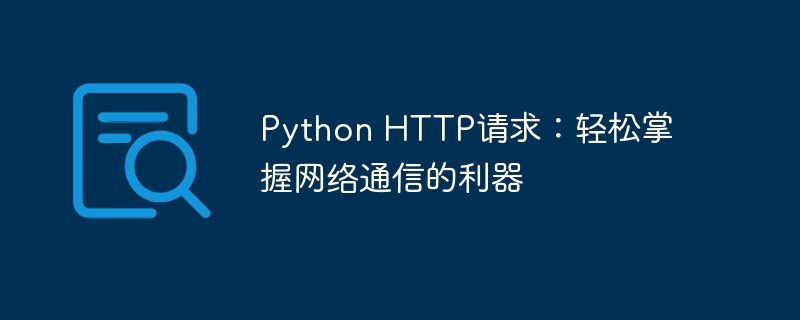

python HttpThe request library is a powerful tool for sending HTTP requests. It provides a set of simple The easy-to-use api enables you to easily communicate with the WEBserver. The HTTP request library has the following characteristics:
Send HTTP request
Sending an HTTP request is very simple. You only need to create an HTTP request object and then use the object to send the request. The following is a demo code:
import requests
# 创建一个HTTP请求对象
url = "http://www.example.com"
response = requests.get(url)
# 检查响应状态码
if response.status_code == 200:
# 请求成功,处理响应内容
print(response.text)
else:
# 请求失败,处理错误
print("请求失败,状态码:", response.status_code)Get request response
After sending the HTTP request, you can get the request response. You can get the response using the text property of the HTTP request object, or you can get the js<strong class="keylink">ON data of the response using the </strong>JSON() method. The following is a demo code:
# 获取响应
response = requests.get("http://www.example.com")
print(response.text)
# 获取响应的JSON数据
response = requests.get("http://www.example.com/api/v1/users")
data = response.json()
print(data)Send POST request
POST request is used to send data to the server. The following is a demo code:
# 发送POST请求
data = {"username": "admin", "passWord": "password"}
response = requests.post("http://www.example.com/login", data=data)
# 检查响应状态码
if response.status_code == 200:
# 登录成功,处理响应内容
print(response.text)
else:
# 登录失败,处理错误
print("登录失败,状态码:", response.status_code)Send PUT request
PUT request is used to update data on the server. The following is a demo code:
# 发送PUT请求
data = {"username": "admin", "password": "new_password"}
response = requests.put("http://www.example.com/users/1", data=data)
# 检查响应状态码
if response.status_code == 200:
# 更新成功,处理响应内容
print(response.text)
else:
# 更新失败,处理错误
print("更新失败,状态码:", response.status_code)Send DELETE request
DELETE request is used to delete data on the server. The following is a demo code:
# 发送DELETE请求
response = requests.delete("http://www.example.com/users/1")
# 检查响应状态码
if response.status_code == 200:
# 删除成功,处理响应内容
print(response.text)
else:
# 删除失败,处理错误
print("删除失败,状态码:", response.status_code)Summarize
HTTP request library is a powerful tool in Python for sending HTTP requests. It provides rich methods and flexible configuration, allowing you to easily communicate with the web server. This article introduces how to use the HTTP request library to send GET, POST, PUT, DELETE and other requests, and how to obtain the request response.
The above is the detailed content of Python HTTP request: a powerful tool for easily mastering network communication. For more information, please follow other related articles on the PHP Chinese website!




